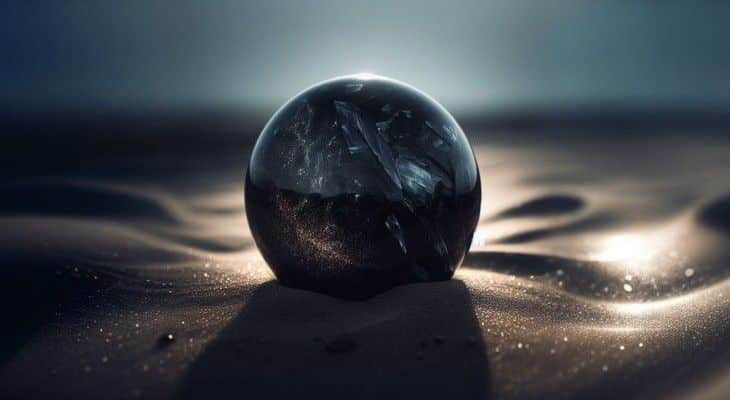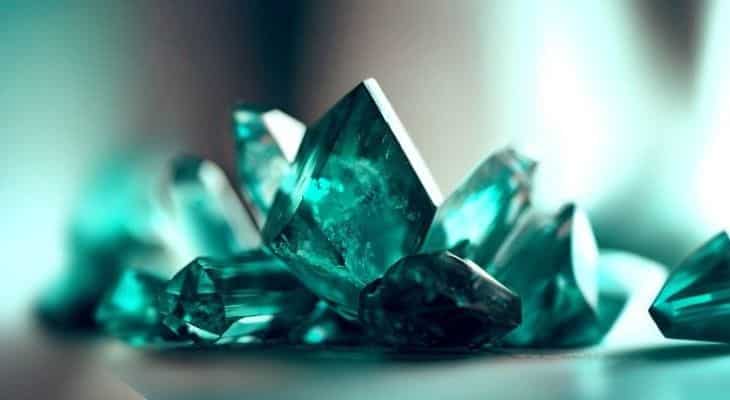
Light orange crystal names
Here is a list of rocks, stones, and minerals with a light orange color, along with a brief description of each and some tips on how to differentiate them:
- Carnelian: Carnelian is a variety of chalcedony that is typically light to dark orange in color. It often forms in volcanic rocks and owes its orange color to the presence of iron oxide impurities. To differentiate carnelian from other orange stones, look for its waxy luster and uniform color.
- Amber: Amber is fossilized tree resin that can range in color from yellow to orange to red. The orange color in amber is often due to the presence of organic compounds that interact with the crystal’s structure. To differentiate amber from other orange stones, look for its light weight, warm temperature, and the occasional presence of trapped insects or other organic material.
- Sunstone: Sunstone is a variety of feldspar that is typically orange to reddish-brown in color. The orange color is due to tiny copper or iron inclusions within the crystal, which scatter light in a way that produces the characteristic shimmering effect. To differentiate sunstone from other orange stones, look for its glittering appearance and the occasional presence of small metallic inclusions.
- Spessartine: Spessartine is a type of garnet that is typically orange to red-brown in color. Its orange hue is due to the presence of manganese in its chemical composition. To differentiate spessartine from other orange stones, look for its high density and the absence of cleavage planes.
- Wulfenite: Wulfenite is a lead molybdate mineral that is typically orange to yellow in color. Its orange hue is due to the presence of lead in its chemical composition. To differentiate wulfenite from other orange stones, look for its high luster and the presence of distinct crystal faces.
Here is a table summarizing the information:
| Name | Color | Composition | Characteristics |
|---|---|---|---|
| Carnelian | Light to dark orange | Chalcedony with iron oxide impurities | Waxy luster, uniform color |
| Amber | Yellow to orange to red | Fossilized tree resin with organic compounds | Light weight, warm temperature, occasionally contains trapped insects |
| Sunstone | Orange to reddish-brown | Feldspar with copper or iron inclusions | Glittering appearance, occasionally contains small metallic inclusions |
| Spessartine | Orange to red-brown | Garnet with manganese | High density, absence of cleavage planes |
| Wulfenite | Orange to yellow | Lead molybdate mineral with lead | High luster, distinct crystal faces |
I hope this helps you differentiate between these lovely light orange stones and minerals!
How to identify a light orange crystal
Here is a step-by-step instruction on identifying a light orange crystal:
- Examine the color: The first step in identifying a light orange crystal is to carefully examine its color. The crystal should be a shade of light orange, which can range from a pale peach color to a deeper, burnt orange hue. It’s important to note that the color of a crystal can be affected by lighting conditions, so be sure to examine it in natural light if possible.
- Check the luster: The luster of a crystal refers to the way it reflects light. A light orange crystal may have a glossy or waxy luster, depending on its composition. Look for a smooth, reflective surface that catches the light in a characteristic way.
- Look for inclusions: Many light orange crystals contain inclusions, or small imperfections within the crystal structure. These inclusions can range from tiny metallic flecks to larger, darker areas. Look for these inclusions, as they can help you identify the specific type of crystal you are examining.
- Test the hardness: The hardness of a crystal can be an important factor in identifying it. Use a hardness test kit or a known mineral specimen to determine the crystal’s hardness on the Mohs scale. Light orange crystals may have a hardness anywhere from 3 to 7, depending on the specific type of crystal.
- Observe the crystal’s shape: The shape of a crystal can provide important clues to its identity. Many light orange crystals have a unique, geometric shape, such as a hexagonal prism or a rhombic dodecahedron. Look for distinct faces or facets on the crystal, as these can help you identify it.
- Compare to known specimens: If you have access to a collection of known mineral specimens, compare the light orange crystal you are examining to these specimens. Look for similarities in color, shape, and other characteristics. This can help you identify the crystal with more confidence.
By following these steps, you should be able to identify a light orange crystal with greater accuracy and confidence. Remember, the process of identifying a crystal can be complex, so take your time and examine the crystal carefully from all angles.
Interesting facts
Here are some interesting facts about light orange crystals:
- Sunstone, a type of feldspar with a light orange color, is known for its unique property of exhibiting a glittery or shimmering effect, known as aventurescence, due to the presence of tiny copper or hematite inclusions.
- Carnelian, a light orange variety of chalcedony, was highly prized by ancient civilizations for its supposed healing properties and was often used to make amulets and talismans.
- Spessartine, a light orange garnet, is named after the Spessart district in Germany where it was first discovered, and is also found in other regions such as Madagascar and Tanzania.
- Wulfenite, a lead molybdate mineral with a light orange to red color, is known for its distinctive hexagonal crystal structure and is commonly found in the southwestern United States and Mexico.
- Light orange crystals are often associated with the sacral chakra in Hindu and yogic traditions, which is thought to be responsible for emotional and creative energy.
- Some cultures believe that light orange crystals can help to enhance focus, concentration, and motivation, as well as promote feelings of warmth and well-being.
- Light orange crystals are sometimes used in jewelry making or as decorative elements due to their unique and vibrant color, which can add a touch of warmth and energy to any setting.
Color explanation
Light orange crystals are truly a mesmerizing sight, aren’t they? I can tell you that the color of a crystal is determined by a multitude of factors. Let’s explore the physical and geological properties that contribute to the light orange hue of some crystals.
First and foremost, it’s important to understand that the color of a crystal is a result of the way it interacts with light. The crystal’s chemical composition and internal structure can affect how it absorbs and reflects light, which in turn affects the color we see.
In the case of light orange crystals, a common culprit is the presence of iron within the crystal. Iron can absorb certain wavelengths of light, which results in a characteristic orange color. This is particularly true in the case of minerals such as carnelian, which is a variety of chalcedony that is typically light to dark orange in color. Carnelian often forms in volcanic rocks, and its orange color is due to the presence of iron oxide impurities.
Another factor that can contribute to the orange color of a crystal is its formation environment. For example, some orange crystals may form in sedimentary rocks that contain organic material. As this material breaks down, it can release pigments that interact with the crystal’s structure to produce an orange color. This is the case with amber, a fossilized tree resin that can range in color from yellow to orange to red, depending on the presence of organic compounds.
The crystal’s internal structure can also play a role in its color. In some cases, light passing through the crystal can be refracted or diffracted in a way that produces an orange hue. This is the case with sunstone, a variety of feldspar that is typically orange to reddish-brown in color. The orange color is due to tiny copper or iron inclusions within the crystal, which scatter light in a way that produces the characteristic shimmering effect.
In summary, the light orange color of some crystals is a complex interplay between their chemical composition, internal structure, and formation environment. Iron impurities, organic pigments, and light scattering effects can all contribute to the beautiful and captivating hues we see in these natural wonders. As a lapidarist, it’s always a joy to work with crystals that exhibit such fascinating and unique properties.
FAQ
What causes a light orange color in crystals?
The light orange color in crystals is often due to the presence of impurities or trace elements within the crystal’s chemical composition. These impurities can alter the way the crystal interacts with light, resulting in a characteristic orange hue.
Are all light orange crystals the same?
No, there are many different types of light orange crystals with unique properties and compositions. Some common light orange crystals include carnelian, sunstone, spessartine, and wulfenite, among others.
How can I tell if a light orange crystal is natural or dyed?
In some cases, light orange crystals may be treated or dyed to enhance or alter their color. To determine whether a crystal is natural or dyed, examine the color closely and look for any signs of treatment, such as uneven color or unnatural-looking inclusions.
Are light orange crystals rare or valuable?
The rarity and value of a light orange crystal can vary depending on its type, size, and quality. Some light orange crystals, such as sunstone or spessartine, may be considered rare and valuable due to their unique properties and relative scarcity.
How do I care for a light orange crystal?
Light orange crystals should be stored in a cool, dry place away from direct sunlight and other sources of heat. To clean the crystal, gently wipe it with a soft cloth or brush, taking care not to scratch the surface. Avoid using harsh chemicals or solvents that could damage the crystal’s surface or alter its color.
Conclusion
In conclusion, light orange crystals are a fascinating and beautiful addition to any mineral collection. By following the steps outlined in this article, you can confidently identify these crystals and gain a deeper appreciation for their unique properties and origins.
Have you seen Light Purple Stones?



Leave a Reply